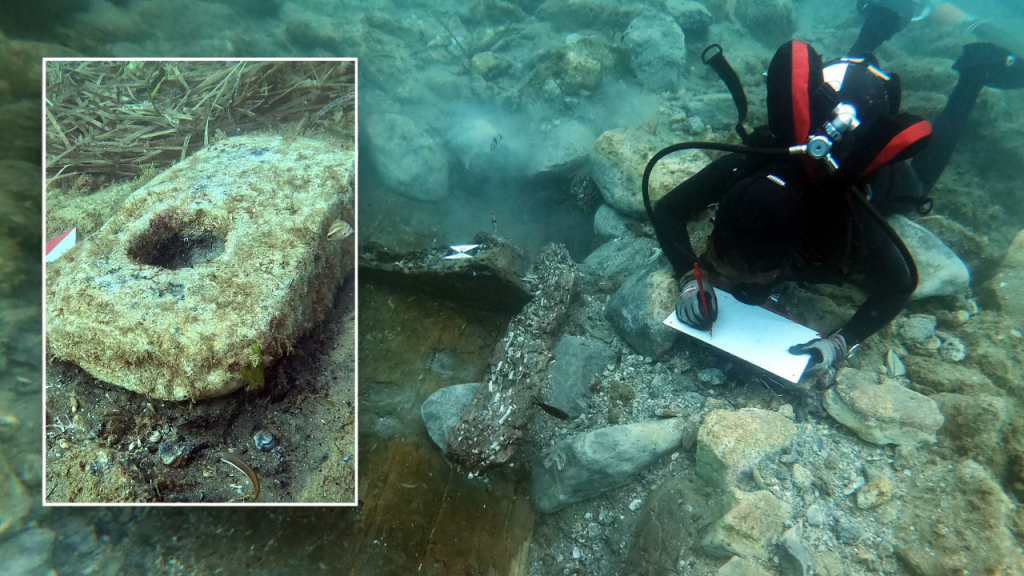A Glimpse into Maritime History: Excavation of a 2,500-Year-Old Shipwreck off the Coast of Sicily
The depths of the Mediterranean Sea continue to yield secrets of the past, as evidenced by the recent discovery of a 2,500-year-old shipwreck off the coast of Sicily. This archaeological marvel, dating back to the 5th or 6th century BC, was unearthed during a three-week underwater excavation near Ragusa, a city in southeastern Sicily. The project, a collaborative effort between the Superintendence of the Sea (SopMare) and the University of Udine, concluded in September and received logistical support from the Italian Coast Guard. Buried beneath layers of sand and rock at a depth of 6 meters (19½ feet), the shipwreck offers a fascinating glimpse into ancient shipbuilding techniques and maritime trade.
The excavation unveiled a hull constructed using the “on the shell” method, a technique where beam boards are interconnected with tenons and mortises, creating a self-supporting structure. This discovery sheds light on the shipbuilding practices prevalent during that era and provides valuable insights into the maritime capabilities of ancient civilizations. Moreover, the excavation yielded a trove of artifacts, including prehistoric lithics (stone tools) and iron anchors dating back to the 7th century AD. The presence of these artifacts suggests a long history of human activity in the area, spanning from prehistoric times to the early medieval period. The juxtaposition of prehistoric tools and later anchors raises intriguing questions about the site’s continuous use and its significance over different historical periods.
The discovery of prehistoric lithics near the shipwreck adds another layer of intrigue to the find. These stone tools, remnants of a much earlier era, suggest that the site may have been occupied or frequented by humans long before the shipwreck occurred. The presence of these tools, alongside the later anchors, paints a picture of a location with sustained human activity across millennia. This raises the possibility that the shipwreck site may have been part of a larger, long-term settlement or a strategically important location for navigation and resource gathering.
The 7th century AD iron anchors, identified as “T” shaped, provide further clues about the maritime history of the area. These anchors, distinct in their design, likely belonged to vessels navigating the Mediterranean Sea during the early medieval period. Their presence near the older shipwreck suggests that the area continued to be used for maritime purposes centuries after the original vessel met its fate. This highlights the enduring importance of this location for seafaring activities and trade throughout history. The discovery of these anchors contributes to our understanding of ancient anchoring techniques and the evolution of maritime technology.
The use of underwater photogrammetry allowed archaeologists to create a detailed three-dimensional model of the wreck. This technology provides a comprehensive visual record of the shipwreck, enabling researchers to study its structure and features in detail. Furthermore, collected samples will undergo paleobotanical analysis, offering further insights into the materials used in the ship’s construction. This analysis can reveal the types of wood used, potentially identifying the geographical origin of the timber and shedding light on ancient trade routes and shipbuilding practices across different regions.
The combination of archaeological findings, including the ship’s hull construction, the assortment of artifacts, and the application of advanced imaging techniques, offers a rich tapestry of information about the past. The discoveries point to a vibrant history of maritime trade and cultural exchange between Greece and Sicily. This reinforces the historical significance of the Mediterranean Sea as a crucial hub for commerce, cultural diffusion, and the movement of people and ideas. The shipwreck serves as a tangible reminder of the region’s interconnected past and its pivotal role in shaping the course of human history. Further investigation and analysis of the artifacts and the shipwreck itself promise to unveil even more secrets about this ancient maritime site and its role in the Mediterranean world.

